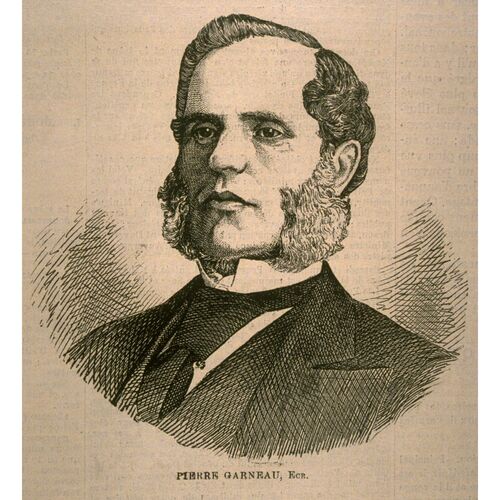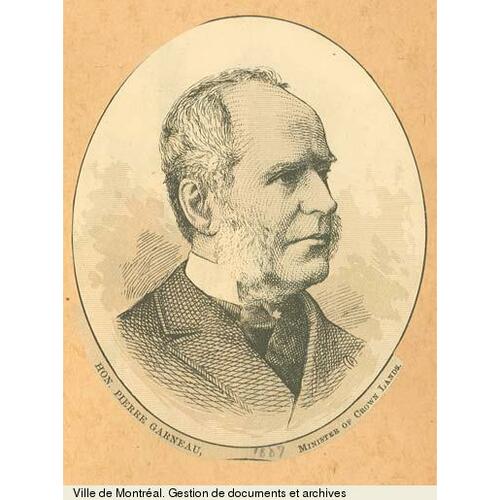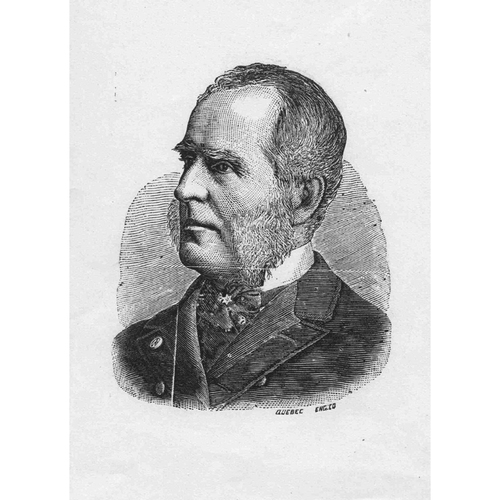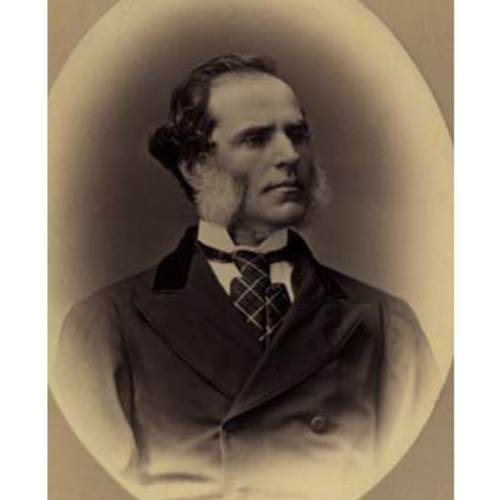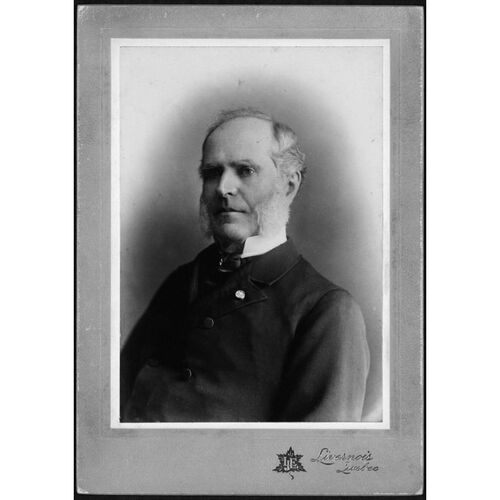![Pierre Garneau [vers 1900] Original title: Pierre Garneau [vers 1900]](/bioimages/w600.14433.jpg)
Source: Link
GARNEAU, PIERRE, businessman and politician; b. 8 May 1823 in Cap-Santé, Lower Canada, son of François-Xavier Garneau, a blacksmith, and Julie-Henriette Gignac; m. 15 Sept. 1857 Charlotte-Louise-Cécile Burroughs at Quebec, and they had three children; d. there 23 June 1905 and was buried 27 June in the cemetery of Notre-Dame de Belmont at Sainte-Foy.
After studying for a short time at Cap-Santé, Pierre Garneau left for Quebec in 1839 and went to work as a clerk for Germain Roberge, a fancy-goods merchant on Rue Saint-Jean. He continued his apprenticeship with Hippolyte Gaudry in 1840–41, the firm of Pelletier et Fréchette in 1842–43, and that of Pierre Boisseau in 1844–47. In 1847 he and Cirice Têtu quit the Boisseau firm and he became a chief clerk in the fancy-goods shop of Cirice and Laurent Têtu on Rue Saint-Jean. He left the Têtus the following year in order to go into partnership with Louis-Eugène Dorion, in the same line of business. His career suffered a serious set-back when he was struck and severely injured by a stone that had come loose from a window. In 1851 he resumed his activities as a partner with the Têtus in L. et C. Têtu et Compagnie. The business, by then located in the Lower Town, had expanded; the Têtus were both retailers and wholesalers, and supplied rural merchants as well. The firm discontinued its retail business the next year and became one of the largest importers in the city. It made substantial profits and built warehouses that held a wide range of products. Garneau, whose particular responsibility was foreign purchases, frequently travelled in Europe. Despite a few bad debts, the company grew steadily during the 1850s. Laurent Têtu retired late in 1860 and Cirice and Pierre continued business under the name of Têtu et Garneau. With annual sales of at least $150,000, the enterprise grew rapidly during the following years, even logging timber limits at Les Escoumins and exporting wood to Great Britain.
In 1870 Têtu et Garneau was dissolved. Garneau carried on in partnership with his brother Joseph-Prudent in P. Garneau et Frère until 1878, even though Joseph-Prudent had to be committed to a mental hospital in 1874. Sales for 1875 were in the neighbourhood of $500,000. From 1878 Garneau was the sole owner of the firm, which in 1882 became P. Garneau, Fils et Compagnie with the addition of two partners, his son Édouard-Burroughs* and his brother François-Xavier.
Enjoying relatively easy circumstances in a well-established operation, Garneau branched out into enterprises of general interest to the business community. From 1866 he was involved in the Quebec and Gulf Ports Steamship Company, which in 1880 became the Quebec Steamship Company. In 1869 he invested in the Quebec and Gosford Railway. He also embarked on a career in municipal politics at Quebec in 1870. Elected alderman for Saint-Pierre ward, he was immediately catapulted into the mayoralty, which he held for four years, from 2 May 1870 [see Adolphe Tourangeau*] until 4 May 1874, having been re-elected in 1872.
Garneau took the plunge into provincial politics in 1873, when as a Conservative he won the seat for Quebec by acclamation, replacing Pierre-Joseph-Olivier Chauveau*. The following year he entered the cabinet of Charles-Eugène Boucher* de Boucherville as commissioner of agriculture and public works. His appointment, in the wake of the Tanneries scandal [see Louis Archambeault*], appears to have been largely due to the support of Hector-Louis Langevin and to his own reputation for thoroughness and honesty. Responsible for agriculture, colonization, immigration, public works, and railways, he proved a shrewd and effective administrator despite his inexperience. He took a particular interest in railways, especially in plans for building lines to Lac Saint-Jean, to the Eastern Townships, and along the north shore of the St Lawrence. He favoured the take-over of the North Shore Railway Company by the province in 1875 and participated as the government’s representative in the creation and administration of the Quebec, Montreal, Ottawa and Occidental Railway. On the question of immigration, he oversaw the giving up in 1875 of the exercise of provincial control over immigration agencies abroad. In his cabinet shuffle of 1876, following the resignation of the treasurer, Joseph Gibb Robertson*, Boucherville decided to take on the Department of Agriculture and Public Works himself in order to manage railway policy more directly and to add weight to his own position. He moved Garneau to the portfolio of commissioner of crown lands, an office of considerable economic importance in which he seems to have shown himself a competent administrator.
Garneau was defeated in the 1878 general election, in the aftermath of the Letellier affair [see Luc Letellier* de Saint-Just], and did not return to the Legislative Assembly until 1881 when he again won the Quebec seat by acclamation. Since he was not in any of the various Conservative cabinets until 1886, he adopted a moderate and rather independent stance, concerning himself mainly with railways and with questions involving the city of Quebec and the surrounding region. He supported the sale of the Quebec, Montreal, Ottawa and Occidental Railway in 1882, although he regretted his decision two years later in the light of government inaction and changes of ownership harmful to the city’s interests. He gave his wholehearted support to the Quebec and Lake St John Railway, then under construction, of which he had been a director from its earliest days. He repeatedly emphasized the importance of fixing up the long-neglected barracks located on land at Quebec that had belonged to the Jesuits, and he spoke when legislation affecting the business community was under discussion. Still a loyal Conservative, even though not in the inner circle, in 1886 he would be drawn into the debates over the fate of Louis Riel*.
Though usually moderate and prudent, Garneau was incensed at the execution of Riel. Along with others who condemned the federal Conservative government’s decision not to commute the death sentence, he participated in protest meetings. He found himself in the company of Liberals and a few members of the provincial Conservatives’ nationalist wing who were disillusioned by the stand of the federal party. All kinds of political strategies were considered, including the formation of a nationalist party. Garneau joined a group of nationalist Conservatives from Quebec, along with Louis-Philippe Pelletier* and Guillaume Amyot* who founded the newspaper La Justice in January 1886. The paper vigorously attacked the federal cabinet but dealt gently with the provincial Conservatives.
On 28 April 1886, subsequent to these activities, Garneau put forward a motion in the house, seconded by Louis Beaubien*, which raised the Riel affair. While eschewing any intent to interfere in matters outside the competence of provincial legislative assemblies, it expressed the “feelings of regret and pain that the people of this province . . . have universally shown at the deplorable execution of Louis Riel, an execution carried out even after the jury’s recommendation for clemency and despite all the reasons which, from a humanitarian point of view, argued in favour of commuting the sentence.” In an exceptional speech Garneau first addressed the objections of members of his own party by recalling precedents for this kind of motion, in particular one that had recently offered support to the Irish and to William Ewart Gladstone [see Felix Carbray]. After recounting the events surrounding the Riel affair, he stated his conviction that the failure to commute the sentence had been the result of “cold ministerial calculation” and a concession to Orangemen. “If my political career must end with what I here consider to be an urgent and sacred duty, I am ready,” he declared, “to accept all the consequences of my act. . . . At my age, one does not shrink before such a responsibility and I will do my duty to the end.”
This motion touched off one of the great debates in the Quebec Legislative Assembly and led to a major regrouping of political forces. Although Garneau’s motion was defeated by the government majority, four Conservatives broke party ranks to vote for it. This division did not develop into an alliance with the Liberals, however, since Garneau and the other dissidents refused to support a Liberal motion censuring the provincial Conservative ministers and they continued to support the government on other questions. With an election in the offing, the situation of the nationalist wing of the Conservatives was becoming complicated and there were difficult decisions to be made. Feeling the resentment his motion had aroused among the Conservatives, and possibly also under the influence of a more extreme group consisting of Pelletier and Georges Duhamel*, Garneau found himself pushed into a “national” alliance with Honoré Mercier*, the leader of the Liberal party. The Conservatives ran a strong candidate against him, Thomas Chase-Casgrain*. On election night Garneau, Pelletier, and Duhamel were all defeated, but five National Conservatives were elected and they held the balance of power. Vilified by the Conservatives during the campaign, the group turned to Mercier, who welcomed them with open arms into a “national” government, formed on 29 Jan. 1887.
Even in defeat, Garneau enjoyed an untarnished reputation and he had solid cabinet experience to his credit. Mercier consolidated the national alliance by offering him the portfolio of commissioner of crown lands, which he had left in 1878, and by appointing him to the Legislative Council on 31 Jan. 1887 for the division of La Durantaye. Garneau would play an important and active role in the Legislative Council as chief government spokesman. When the cabinet was shuffled in August 1888, he was given the new portfolio of public works. He retained it until 1890 and was particularly involved in a number of delicate issues, including the question of the northern boundary of the province. The election of 1890 returned the Parti National to power, but shattered the ranks of the National Conservatives. In the cabinet shuffle that followed, Garneau kept his post. The following year, internal disputes led to the breakup of the National Conservatives, some joining the Liberals and others becoming more radical. Still loyal to Mercier, Garneau remained in office.
The end of Garneau’s ministerial career is clouded by the Baie des Chaleurs Railway scandal and the settlement of a claim made by contractor Charles Newhouse Armstrong for $175,000, of which $100,000 was to be paid to Ernest Pacaud, a fund-raiser for the Liberal party [see Honoré Mercier]. As commissioner of public works, but also as provincial treasurer and acting premier in April 1891, while Mercier was in France, Garneau was subjected to pressure by the company’s representative Angus M. Thom, and by his colleagues Charles Langelier* and Joseph-Emery Robidoux, to authorize payment of the claim. Despite his misgivings and his wish to resign, Garneau signed it in order not to leave the province without a government. When the affair became public in August 1891 and a royal commission of inquiry was set up to investigate it, he had to testify. An interim report, prepared by two commissioners and released on 15 Dec. 1891, accused him of negligence. The final report, dated 8 June 1892, was highly critical, indicating that the “transaction with Thom was concluded with exceptional haste, and that Monsieur Garneau took none of the precautions, requisite from both legal and business perspectives, to guard against eventualities,” but it did not question his honesty. Earlier, on 6 February, the chairman of the commission, Louis-Amable Jetté*, had submitted a minority report. In his view, Garneau “seems to have given this difficult and delicate transaction all the care and all the prudence that he could bring to bear on it and there is absolutely nothing in the evidence that could give rise to the slightest suspicion about his utter honesty and honourableness.” None of the interpretations questioned his integrity; they differed, however, on the extent of the precautions he should have taken as a public administrator, and the criteria employed in the assessments were rather subjective and political in part. Be that as it may, the interim report led Lieutenant Governor Auguste-Réal Angers* to withdraw his support from Premier Mercier on 16 Dec. 1891. A new Conservative government was formed, and Garneau’s cabinet career came to an end. However, he continued to be active in the Legislative Council until he resigned on 4 April 1904.
Like many merchants of his time who entered politics, Garneau maintained, in addition to his family business, financial interests and directorships in all kinds of enterprises. In the field of transportation, he had investments in the Quebec Steamship Company, the Quebec Street Railway Company, the Quebec and Lake St John Railway, the North Shore Railway, and the Great Northern Railway Company. In the financial sector, he was associated at various levels with the Banque Nationale, the Stadacona Bank, and the Quebec Fire Assurance Company. He was also involved with firms in a variety of other fields: the De Léry Gold Mining Company, the Quebec Rubber Company, which changed its name in 1877 to the North American Works, and the Riverside Worsted Company. With an unawareness of conflict of interest that was common in his time, Garneau sometimes spoke in support of these enterprises during parliamentary debates.
Along with all his other activities, Garneau continued to manage the affairs of P. Garneau, Fils et Compagnie. The firm’s credit rating and overall situation improved substantially at the beginning of the 1880s, and then more gradually in the years up until Garneau’s death. Another son, Georges*, came into the business. Garneau left the day-to-day management of the firm to his partners. The partnership agreement of 1889 gave him control of the business, a return of 5 per cent on his share of the capital, and the right to withdraw parts of it at will. He could expel one of his partners and require the others to devote all their time to the business. In return, he let them share the profits (and the losses): 35 per cent for François-Xavier and the rest, in varying proportions, for his two sons. Under the terms of a new contract that divided the profits into three equal parts, Georges’s share grew from 15 per cent in 1889 to 33 per cent in 1891. Garneau’s various wills named his sons as heirs to the residue of all his possessions. When he died on 23 June 1905, he left nearly half a million dollars ($462,527), of which $340,000 represented his share of the firm’s capital.
Strangely enough, the course of Pierre Garneau’s career was similar to that of Isidore Thibaudeau*, a neighbour in Cap-Santé whose father, Pierre-Chrisologue, was his godfather. They had both gone into the business of wholesaling and importing fancy goods, with resounding success, and became neighbours again on Rue Dalhousie in the Lower Town of Quebec. Garneau, however, was destined to have a markedly fuller political career.
AC, Québec, Minutiers, L.-P. Sirois; Cyrille Tessier. ANQ-Q, CE1-1, 15 sept. 1857, 27 juin 1905; CE1-8, 8 mai 123; T11-1/4451–54. Baker Library, R. G. Dun & Co. credit ledger, Canada, 8: 14, 16, 71, 109, 119, 153, 186, 242–43, 256. Le Soleil, 23–24, 27 juin 1905. A[uguste] Béchard, L’Hon. Pierre Garneau (Saint-Hyacinthe, Qué., 1884). Benoit, “Le développement des mécanismes de crédit et la croissance économique d’ une communauté d’ affaires.” Bradstreet commercial report, 1859–1905. M. Hamelin, Premières années du parlementarisme québécois. Charles Langelier, Souvenirs politiques [de 1878 à 1896] (2v., Québec, 1909–12), 2. Mercantile agency reference book, 1859–1905. Poulin, “Déclin portuaire et industrialisation.” Qué., Assemblée Législative, Débats, 28 avril 1886: 563–76; Royal commission, inquiry into the Baie des Chaleurs Railway matter, Reports . . . (Quebec, 1892). Rumilly, Mercier et son temps.
Cite This Article
Marc Vallières, “GARNEAU, PIERRE,” in Dictionary of Canadian Biography, vol. 13, University of Toronto/Université Laval, 2003–, accessed December 28, 2025, https://www.biographi.ca/en/bio/garneau_pierre_13E.html.
The citation above shows the format for footnotes and endnotes according to the Chicago manual of style (16th edition). Information to be used in other citation formats:
| Permalink: | https://www.biographi.ca/en/bio/garneau_pierre_13E.html |
| Author of Article: | Marc Vallières |
| Title of Article: | GARNEAU, PIERRE |
| Publication Name: | Dictionary of Canadian Biography, vol. 13 |
| Publisher: | University of Toronto/Université Laval |
| Year of publication: | 1994 |
| Year of revision: | 1994 |
| Access Date: | December 28, 2025 |


